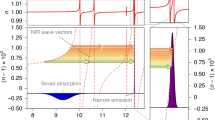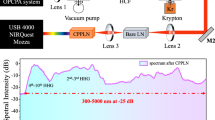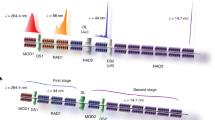Abstract
We report results on the performance of a free-electron laser operating at a wavelength of 13.7 nm where unprecedented peak and average powers for a coherent extreme-ultraviolet radiation source have been measured. In the saturation regime, the peak energy approached 170 µJ for individual pulses, and the average energy per pulse reached 70 µJ. The pulse duration was in the region of 10 fs, and peak powers of 10 GW were achieved. At a pulse repetition frequency of 700 pulses per second, the average extreme-ultraviolet power reached 20 mW. The output beam also contained a significant contribution from odd harmonics of approximately 0.6% and 0.03% for the 3rd (4.6 nm) and the 5th (2.75 nm) harmonics, respectively. At 2.75 nm the 5th harmonic of the radiation reaches deep into the water window, a wavelength range that is crucially important for the investigation of biological samples.
This is a preview of subscription content, access via your institution
Access options
Subscribe to this journal
Receive 12 print issues and online access
$209.00 per year
only $17.42 per issue
Buy this article
- Purchase on Springer Link
- Instant access to full article PDF
Prices may be subject to local taxes which are calculated during checkout






Similar content being viewed by others
References
Matthews, D. L. et al. Demonstration of a soft x-ray amplifier. Phys. Rev. Lett. 54, 110–113 (1985).
MacGowan, B. J. et al. Demonstration of soft x-ray amplification in nickel-like ions. Phys. Rev. Lett. 59, 2157–2160 (1987).
Zeitoun, Ph. et al. A high-intensity highly coherent soft X-ray femtosecond laser seeded by a high harmonic beam. Nature 431, 426–429 (2004).
Ferray, M. et al. Multiple-harmonic conversion of 1064 nm radiation in rare gases. J. Phys. B 21, L31–L33 (1988).
Li, X. F., L'Huillier, A., Ferray, M., Lompre', L. A. & Mainfray, G. Multiple-harmonic generation in rare gases at high laser intensity. Phys. Rev. A 32, 5751–5761 (1989).
Dromey, B. et al. High harmonic generation in the relativistic limit. Nature Phys. 3, 456–459 (2006).
Kondratenko, A. M. & Saldin, E. L. Generation of coherent radiation by a relativistic electron beam in an undulator. Part. Accelerators 10, 207–216 (1980).
Derbenev, Ya. S., Kondratenko, A. M. & Saldin, E. L. On the possibility of using a free-electron laser for polarization of electrons in storage rings. Nucl. Instrum. Methods 193, 415–421 (1982).
Murphy, J. B. & Pellegrini, C. Free electron lasers for the XUV spectral region. Nucl. Instrum. Methods A 237, 159–167 (1985).
Hogan, M. et al. Measurements of gain larger than 105 at 12 µm in a self-amplified spontaneous-emission free-electron laser. Phys. Rev. Lett. 81, 4867–4870 (1998).
Milton, S. V. et al. Exponential gain and saturation of a self-amplified spontaneous emission free-electron laser. Science 292, 2037–2041 (2001).
Ayvazyan, V. et al. Generation of GW radiation pulses from a VUV free-electron laser operating in the femtosecond regime. Phys. Rev. Lett. 88, 104802 (2002).
Ayvazyan, V. et al. A new powerful source for coherent VUV radiation: Demonstration of exponential growth and saturation at the TTF free-electron laser. Eur. Phys. J. D 20, 149–156 (2002).
Ayvazyan, V. et al. First operation of a free-electron laser generating GW power radiation at 32 nm wavelength. Eur. Phys. J. D 37, 297–303 (2006).
Wabnitz, H. et al. Multiple ionization of atom clusters by intense soft X-rays from a free-electron laser. Nature 420, 482–485 (2002).
Meyer, M. et al. Two-color photoionization in xuv free-electron and visible laser fields. Phys. Rev. A 74, 011401 (2006).
Sorokin, A. A., Bobashev, S. V., Tiedtke. K. & Richter, M. Multi-photon ionization of molecular nitrogen by femtosecond soft x-ray FEL pulses. J. Phys. B 39, L299–L304 (2006).
Sobierajski, R. et al. Experimental station to study the interaction of intense femtosecond vacuum ultraviolet pulses with matter at TTF1 free electron laser. Rev. Sci. Instrum. 76, 013909 (2005).
Chapman, H. N. et al. Femtosecond diffractive imaging with a soft-X-ray free-electron laser. Nature Phys. 2, 839–843 (2006).
Altarelli, M. et al. (Eds) XFEL: The European X-Ray Free-Electron Laser. Technical Design Report. Preprint DESY 2006–097, (DESY, Hamburg, 2006) (see also http://xfel.desy.de).
Merkel, A. German Science Policy 2006. Science 313, 147 (2006).
Arthur, J. et al. Linac Coherent Light Source (LCLS). Conceptual Design Report. SLAC- R593 (Stanford, 2002) (see also <http://www-ssrl.slac.stanford.edu/lcls/cdr>).
Tanaka, T. & Shintake, T. (Eds) SCSS X-FEL Conceptual Design Report (Riken Harima Institute, Hyogo, Japan,) May 2005 (see also <http://www-xfel.spring8.or.jp>).
Saldin, E. L., Schneidmiller, E. A. & Yurkov, M. V. The Physics of Free Electron Lasers (Springer, Berlin, 1999).
Bonifacio, R., Pellegrini, C. & Narducci, L. M. Collective instabilities and high-gain regime in a free-electron laser. Opt. Commun. 50, 373 (1984).
Dohlus, M. et al. Start-to-end simulations of SASE FEL at the TESLA Test Facility, phase 1. Nucl. Instrum. Methods A 530, 217–233 (2004).
Krinsky, S. & Huang, Z. Frequency chirped self-amplified spontaneous-emission free-electron lasers. Phys. Rev. ST Accel. Beams 6, 050702 (2003).
Saldin, E. L., Schneidmiller, E. A. & Yurkov, M. V. Self-amplified spontaneous emission FEL with energy-chirped electron beam and its application for generation of attosecond x-ray pulses. Phys. Rev. ST Accel. Beams 9, 050702 (2006).
Bytchkov, A. et al. Development of MCP-based photon diagnostics at the TESLA Test Facility at DESY. Nucl. Instrum. Methods A 528, 254–257 (2004).
Richter, M. et al. Measurement of gigawatt radiation pulses from a vacuum and extreme ultraviolet free-electron laser. Appl. Phys. Lett. 83, 2970–2972 (2003).
Saldin, E. L., Schneidmiller, E. A. & Yurkov, M. V. Statistical properties of radiation from VUV and X-ray free electron laser. Opt. Commun. 148, 383–403 (1998).
Martins, M. et al. Monochromator beamline for FLASH. Rev. Sci. Instrum. 77, 115108 (2006).
Colson, W. Free-electron lasers operating in higher harmonics. Phys. Rev. A 24, 639–641 (1981).
Freund, H., Biedron, S. & Milton, S. Nonlinear harmonic generation in free-electron lasers. IEEE J. Quant. Electron. 36, 275–281 (2000).
Huang, Z, & Kim, K. Three-dimensional analysis of harmonic generation in high-gain free-electron lasers. Phys. Rev. E. 62, 7295–7308 (2000).
Saldin, E. L., Schneidmiller, E. A. & Yurkov, M. V. Properties of the third harmonic of the radiation from self-amplified spontaneous emission free electron laser. Phys. Rev. ST Accel. Beams 9, 030702 (2006).
Geloni, G., Saldin, E. L., Schneidmiller, E. A. & Yurkov, M. V. Exact solution for second harmonic generation in XFELs, Opt. Commun. 271, 207–218 (2007).
Saldin, E. L., Schneidmiller, E. A. & Yurkov, M. V. FAST: A three-dimensional time-dependent FEL simulation code. Nucl. Instrum. Methods A 429, 233–237 (1999).
Tiedtke, K. et al. The SASE FEL at DESY: photon beam diagnostics for the user facility. AIP Conf. Proc. 705, 588–592 (2004).
Nicolosi, P. et al. Grazing–incidence spectrometer for the monitoring of the VUV FEL beam at DESY. J. Electron. Spec. Relat. Phenom. 144, 1055 (2005).
Kita, T., Harada, T, Nakano, N. & Kuroda, H. Mechanically ruled aberration-corrected concave gratings for a flat-field grazing-incidence spectrograph. Appl. Opt. 22, 512 (1983).
Acknowledgements
The authors are indebted to the invaluable support of the technical staff of DESY and participating groups from the TESLA Technical Collaboration.
Author information
Authors and Affiliations
Corresponding author
Ethics declarations
Competing interests
The authors declare no competing financial interests.
Supplementary information
Supplementary Information
Supplementary information, figures S1-S7, tables S1-S2 (PDF 256 kb)
Rights and permissions
About this article
Cite this article
Ackermann, W., Asova, G., Ayvazyan, V. et al. Operation of a free-electron laser from the extreme ultraviolet to the water window. Nature Photon 1, 336–342 (2007). https://doi.org/10.1038/nphoton.2007.76
Received:
Revised:
Accepted:
Published:
Issue Date:
DOI: https://doi.org/10.1038/nphoton.2007.76
This article is cited by
-
Ultrafast entropy production in pump-probe experiments
Nature Communications (2024)
-
Ultrafast demagnetization in bulk nickel induced by X-ray photons tuned to Ni M3 and L3 absorption edges
Scientific Reports (2024)
-
Progress and prospects in nonlinear extreme-ultraviolet and X-ray optics and spectroscopy
Nature Reviews Physics (2023)
-
Self-organization of photoionized plasmas via kinetic instabilities
Reviews of Modern Plasma Physics (2023)
-
X-ray induced Coulomb explosion imaging of transient excited-state structural rearrangements in CS2
Communications Physics (2023)



